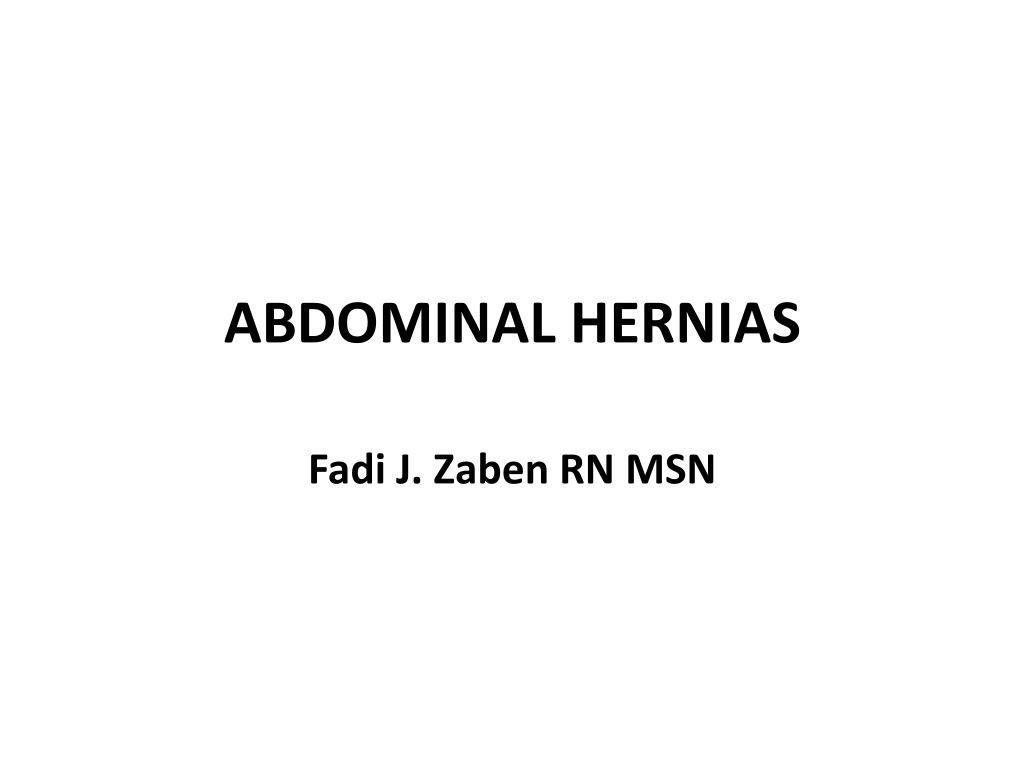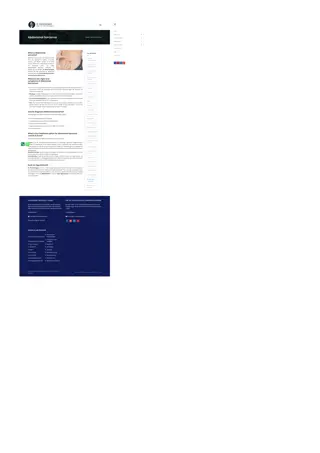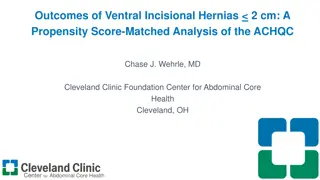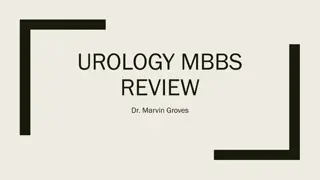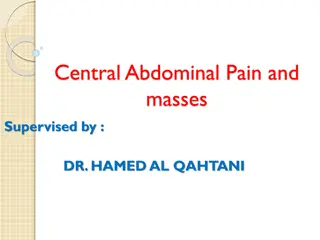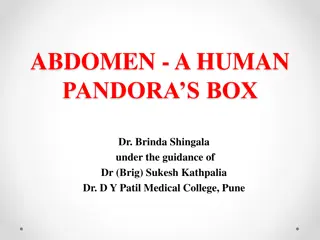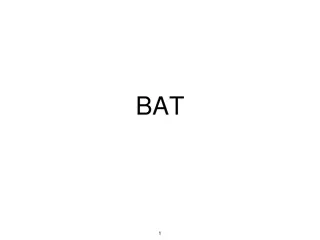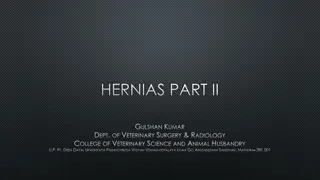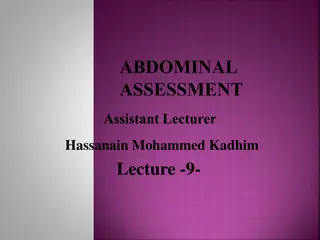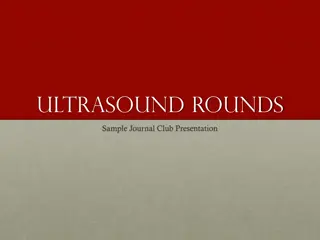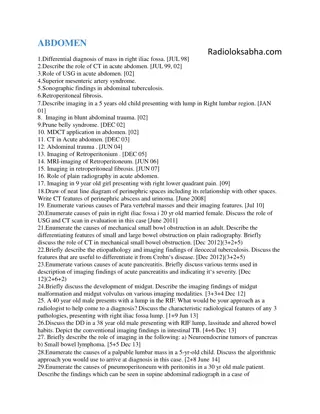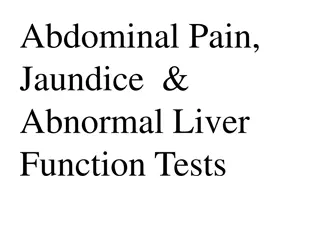ABDOMINAL HERNIAS
Abdominal hernias occur when organs or tissues protrude through the abdominal wall, often caused by congenital or acquired weaknesses. Learn about the etiology, classification by site, and severity of abdominal hernias such as inguinal, femoral, umbilical, ventral, and peristomal hernias.
Download Presentation

Please find below an Image/Link to download the presentation.
The content on the website is provided AS IS for your information and personal use only. It may not be sold, licensed, or shared on other websites without obtaining consent from the author. Download presentation by click this link. If you encounter any issues during the download, it is possible that the publisher has removed the file from their server.
E N D
Presentation Transcript
ABDOMINAL HERNIAS Fadi J. Zaben RN MSN
Definition: A hernia is a protrusion of an organ, tissue, or structure through the wall of the cavity in which it is normally contained. It is often called a rupture. The abdomen is a common place for hernias to occur. Hernias may be present at birth due to incomplete closure of a structure, or they may develop later due to increased abdominal pressure pushing against a weakened area of muscle or its fibrous sheath (fascia).
Etiology: Results from congenital or acquired weakness (traumatic injury, aging) of the abdominal wall. May result from increased intra-abdominal pressure due to heavy lifting, obesity, pregnancy, straining, coughing, or proximity to tumor.
Classification: 1. Classification by Site. 2. Classification by Severity.
Classification by Site: 1. Inguinal Hernia into the inguinal canal (more common in males). A. Indirect inguinal: It occurs due to a weakness of the abdominal wall at the point through which the spermatic cord emerges in the male and the round ligament in the female. Through this opening, the hernia extends down the inguinal canal and often into scrotum or labia. B. Direct inguinal: It passes through the posterior inguinal wall; more difficult to repair than indirect inguinal hernia.
Continue.. 2. Femoral Hernia into the femoral canal, appearing below the inguinal ligament. 3. Umbilical Intestinal Protrusion at the umbilicus due to failure of umbilical orifice to close. Occurs most often in obese women, children, and in patients with increased intra- abdominal pressure from cirrhosis and ascites.
Continue.. 4. Ventral or Incisional Intestinal Protrusion due to weakness at the abdominal wall; may occur after impaired incisional healing due to infection or drainage. 5. Peristomal Hernia through the fascial defect around a stoma and into the subcutaneous tissue.
Classification by Severity: 1. Reducible Hernia: the protruding mass can be placed back into abdominal cavity. 2. Irreducible Hernia: the protruding mass cannot be moved back into the abdomen.
Continue. 3. Incarcerated Hernia: an irreducible hernia in which the intestinal flow is completely obstructed. 4. Strangulated Hernia: an irreducible hernia in which the blood and intestinal flow are completely obstructed; develops when the loop of intestine in the sac becomes twisted or swollen and a constriction is produced at the neck of the sac.
Risk Factors for Abdominal Hernia: Abdominal surgery. Chronic constipation. Chronic cough. Enlargement of the prostate or other conditions that can lead to straining to urinate. Family history of hernias. Lifting or pushing heavy objects. Male gender. Nutritional deficiencies. Obesity. Overexertion. Smoking. Undescended testes.
Clinical Manifestations: Bulging over herniated area appears when patient stands or strains, and disappears when supine. Pain. Hernia tends to increase in size and recurs with intra-abdominal pressure. Strangulated hernia presents with pain, vomiting, swelling of hernial sac, lower abdominal signs of peritoneal irritation, fever.
Diagnostic Evaluation: Based on clinical manifestations: Physical Examination (P/E). Abdominal X-rays: reveal abnormally high levels of gas in the bowel. Laboratory studies (complete blood count, electrolytes) may show hemoconcentration (increased hematocrit), dehydration (increased or decreased sodium), and elevated white blood cell (WBC) count, if incarcerated.
Management: 1. Mechanical (non surgical) treatment. 2. Surgical treatment.
Mechanical Treatment: 1) It is for reducible hernia only. 2) Truss: It is an appliance with a pad and belt that is held snugly over a hernia to prevent abdominal contents from entering the hernial sac. A truss provides external compression over the defect. It should be removed at night and reapplied in the morning before patient arises. It is used only when a patient is not a surgical candidate.
Continue.. 3) Peristomal hernia is often managed with a hernia support belt with Velcro, which is placed around an ostomy pouching system (similar to a truss). 4) Conservative measures: No heavy lifting. NO straining at stool. And any measures that would increase intra- abdominal pressure should be a void.
Surgical Treatment: It recommended to correct hernia before strangulation occurs, which then becomes an emergency situation. Herniorrhaphy: removal of hernial sac; contents replaced into the abdomen; layers of muscle and fascia sutured. Laparoscopic herniorrhaphy is a possibility and often performed as outpatient procedure. Hernioplasty involves reinforcement of suturing (often with mesh) for extensive hernia repair. Strangulated hernia requires resection of ischemic bowel in addition to repair of hernia.
Complications: 1. Bowel obstruction. 2. Recurrence of hernia.
Nursing Assessment: 1. Ask patient if hernia is enlarging and uncomfortable, reducible or irreducible; determine relationship to exertion and activities. 2. Assess bowel sounds and determine bowel pattern. 3. Determine if patient is exhibiting signs and symptoms of strangulation
Nursing Diagnoses: Chronic Pain related to bulging hernia (mechanical). Acute Pain related to surgical procedure. Risk for Infection related to emergency procedure for strangulated or incarcerated hernia.
Nursing Interventions: Achieving Comfort: 1. Fit patient with truss or belt when hernia is reduced, if ordered. 2. Trendelenburg's position may reduce pressure on hernia, when appropriate. 3. Emphasize to patient to wear truss under clothing and to apply before getting out of bed when hernia is reduced. 4. Give stool softeners as directed. 5. Evaluate for signs and symptoms of hernial incarceration or strangulation. 6. Insert NG tube for incarcerated hernia, if ordered, to relieve intra-abdominal pressure on herniated sac.
Relieving Pain Postoperatively: 1. Have the patient splint the incision site with hand or pillow when coughing to lessen pain and protect site from increased intra-abdominal pressure. 2. Administer analgesics, as ordered. 3. Teach about bed rest, intermittent ice packs, and scrotal elevation as measures used to reduce scrotal edema or swelling after repair of an inguinal hernia. 4. Encourage ambulation as soon as permitted. 5. Advise patient that difficulty in urinating is common after surgery; promote elimination to avoid discomfort, and catheterize if necessary.
Preventing Infection: 1. Check dressing for drainage and incision for redness and swelling. 2. Monitor for other signs and symptoms of infection: fever, chills, malaise, diaphoresis. 3. Administer antibiotics, if appropriate.
Patient Education and Health Maintenance: A. Advise that pain and scrotal swelling may be present for 24 to 48 hours after repair of an inguinal hernia. 1. Apply ice intermittently. 2. Elevate scrotum, and use scrotal support. 3. Take medication prescribed to relieve discomfort. B. Teach to monitor self for signs of infection: pain, drainage from incision, temperature elevation. Also, report continued difficulty in voiding. C. Inform that heavy lifting should be avoided for 4 to 6 weeks. Athletics and extremes of exertion are to be avoided for 8 to 12 weeks postoperatively, per provider instructions.
